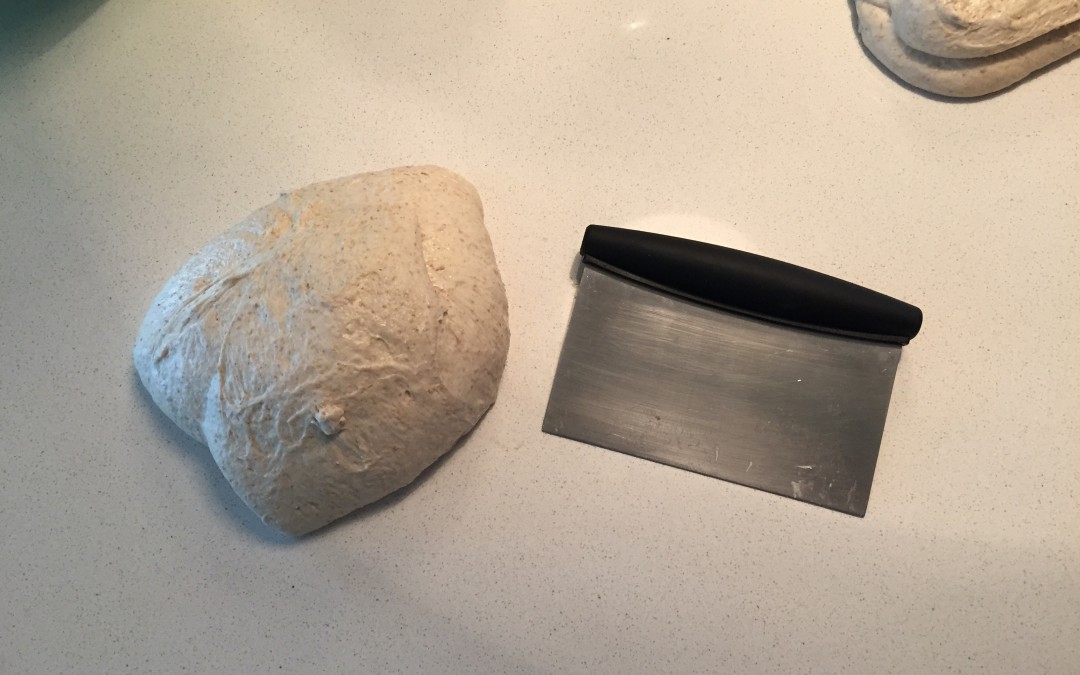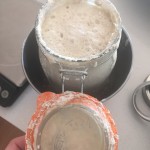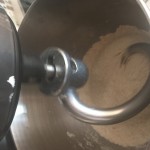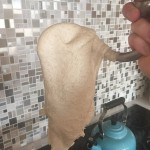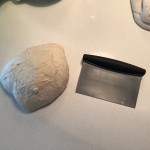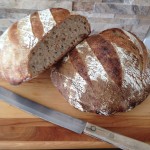- The starter is ready to go!
- Mixing the dough.
- Dough is ready to rise overnight in the fridge.
- Shaping the dough.
- One of my first loaves of sourdough in Edmonton!
There are a lot of food related things that I could say, “is there anything better than…?” and I’m sure I’ve said it numerous times on my blog. But, is there anything better than a slice of still warm, homemade sourdough smothered in butter? I finally mastered (again) sourdough after being home from Ireland for about three months. It took a lot of persistence, a lot of loaves that went right into the bin, and a lot of starter that oozed out and went straight into the bin, but… I had a good-ish idea of what was going wrong, and stuck with my gut.
Although I wanted to bring my starter home from Ireland, which was Tim’s starter from the school, I knew that it was a disaster waiting to happen and I would have starter all over my suitcase (or get pulled aside in the customs line!), so I left it behind. I started two different ones when I got home, one was a Richard Bertinet recipe, and seemed to multiply far too quickly, and still left me with a loaf that wouldn’t rise. I thought I should push on with the Tim’s recipe since I knew exactly what I was looking for. The starter just wasn’t strong enough, and the flours were different, so it took a bit of patience and tweaking of the recipe to get each step to where I wanted it. I’ve had several successful loaves, and although I’m missing Kerrygold butter, it’s just like the sourdough I made at the school. The best part, I am using organic flours that are grown locally, from John Schneider at Gold Forest Grains.
Sourdough is a slow fermented bread that not everyone loves the flavour of, but I think it’s fantastic. People that have a gluten intolerance sometimes find that sourdough is a bread they can eat without difficulty – I’ve tried it on a few people and been successful. For a lot of people the thought of making sourdough seems over whelming and far too time consuming to consider, which I can understand. I am still trying to get into a routine myself so that I always have homemade sourdough in the house, but it’s easy to fall back onto other simple breads to have homemade bread in the house.
A starter is made from flour and water, and uses the natural yeast in the air, it slowly ferments, and needs to be fed with more flour and water. From there you add more – you guessed it! – flour and water, with a little salt. Unlike most bread that I would insist on trying to knead by hand (at least while you learn the different recipes), sourdough is far too wet to knead by hand. After kneading the dough in a mixer, the dough then goes into the fridge covered overnight to ferment and rise. The next day, the dough is shaped, by stretching the dough you work the gluten and finally the dough is put into a wicker basket to rise and ferment further. Depending on how “sour” you like your sourdough, this step can be longer or shorter, I generally leave mine to rise in the fridge for 24 – 36 hours. The dough is then tipped out of the basket into a cast iron pan, slashed and immediately put into a HOT oven, and baked. This is the point where I really noticed that my starter wasn’t “old” enough or strong enough when I first tried to make sourdough after coming home. It would start to rise, but it would never get a true oven spring, the air bubbles from the long rise weren’t properly formed, and the crumb wasn’t quite as lovely as I remembered. But, as I said I persisted and, the oven rise seemed to improve, the bubbles seemed to be better, and all in all I had a proper loaf of sourdough coming out of the oven. My three and a half year old niece Olivia often comes over and asks for homemade bread with butter, and I can’t really blame her… It’s pretty delicious and far better than the rubbish you can buy in the store.
I’ll leave you with a quote from a brilliant cookbook on bread making, “Dough,” by Richard Bertinet. Something to think about for sure…
“ [A] store bought loaf typically contains – wheat flour, water, yeast, wheat protein, salt, vinegar, dextrose, soya flour, vegetable fat, emulsifier E472e (mono and diacetyle tartaric acid esters of mono – and diglycerides of fatty acids), flour treatment agent…… [A] homemade loaf contains – flour, yeast, salt and water.” – Richard Bertinet

